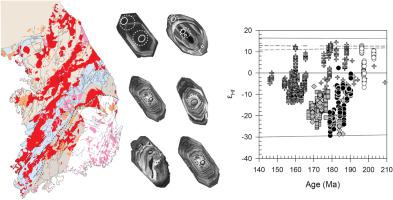当前位置:
X-MOL 学术
›
Gondwana Res.
›
论文详情
Our official English website, www.x-mol.net, welcomes your feedback! (Note: you will need to create a separate account there.)
Tectonomagmatic evolution of a Jurassic Cordilleran flare-up along the Korean Peninsula: Geochronological and geochemical constraints from granitoid rocks
Gondwana Research ( IF 6.1 ) Pub Date : 2020-12-01 , DOI: 10.1016/j.gr.2020.06.025 Albert Chang-sik Cheong , Hui Je Jo
Gondwana Research ( IF 6.1 ) Pub Date : 2020-12-01 , DOI: 10.1016/j.gr.2020.06.025 Albert Chang-sik Cheong , Hui Je Jo

|
Abstract This study used new and published U-Pb geochronological, chemical, and Sr-Nd-Hf-O isotopic data (n > 2500) from Jurassic granite-granodiorite-diorite-monzonite-gabbro plutons in the southern part of the Korean Peninsula to assess the spatiotemporal evolution of a flare-up magmatism, its tectonic connection, and specific contributions of mantle and crustal reservoirs to the magmas generated. After a ~15 m.y. magmatic gap in the Late Triassic, calc-alkaline granitoids intruded into the outboard Yeongnam Massif, then magmatic activity migrated systematically toward the inboard Gyeonggi Massif. The early phase of the Jurassic magmatism is represented by relatively sodic plutons showing distinctly primitive isotopic signatures. The crustal signature of the plutons became increasingly prominent with decreasing age. Voluminous inboard plutons in the Gyeonggi Massif and the intervening Okcheon Belt are dominated by Middle Jurassic peraluminous granites that show isotopic compositions conspicuously shifted toward old crustal values. The Nd-Hf isotopic compositions of the inboard plutons are distinctly less radiogenic than those of Jurassic plutons in Southwest Japan and southeastern China, which corroborates the North China affinity of the Yeongnam and Gyeonggi massifs. The geochronological and geochemical data compiled in this study suggest a tectonomagmatic model consisting sequentially of (1) an extension-dominated arc system in the margin of the Yeongnam Massif (ca. 200–190 Ma); (2) low-angle subduction and the development of an advancing arc system (ca. 190–180 Ma); (3) continued low-angle subduction, extensive underthrusting of fertile crustal materials to the arc root, and consequent magmatic flare-up (ca. 180–170 Ma); and (4) flat subduction and the development of the Honam Shear Zone (ca. 170–160 Ma). The subsequent magmatic lull and previous dating results for synkinematic rocks and minerals indicate that the compressional arc system was maintained until the Early Cretaceous.
更新日期:2020-12-01



























 京公网安备 11010802027423号
京公网安备 11010802027423号